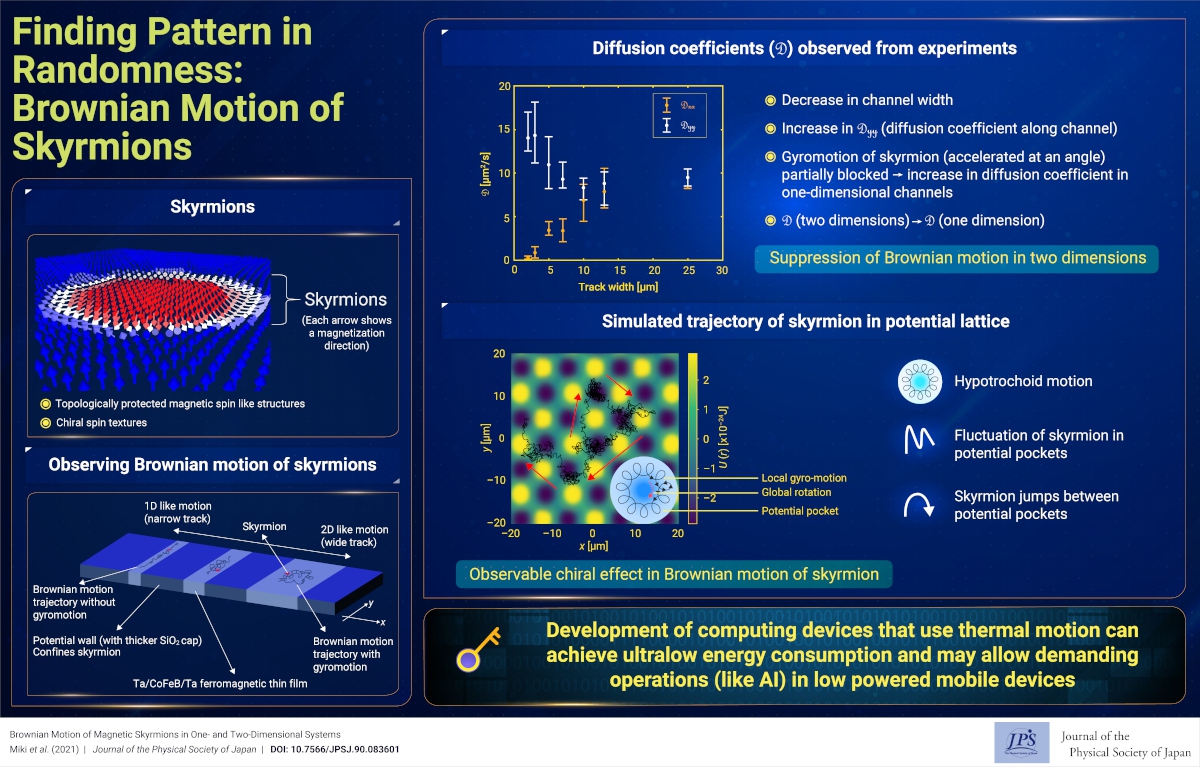Finding Pattern in Randomness: Brownian Motion of Skyrmions
© The Physical Society of Japan
This article is on
Brownian Motion of Magnetic Skyrmions in One- and Two-Dimensional Systems
(JPSJ Editors' Choice)
J. Phys. Soc. Jpn. 90, 083601 (2021).
The chiral properties of the Brownian motion of magnetic skyrmions in one- and two-dimensional systems in thermal equilibrium are reported.

Magnetic skyrmions exhibit unique dynamical properties. However, it is unclear whether the Brownian motion of skyrmions exhibits chiral properties in thermal equilibrium derived from the Magnus force. For example, when a skyrmion is driven by an electric current, the driving force is parallel to the current. However, its trajectory is bent by the Magnus force, which is proportional to the skyrmion number. Consequently, the skyrmion Hall effect is observed. Such chiral motion of skyrmions has been observed in the presence of a driving force. However, whether the Brownian motion of skyrmions exhibits chiral properties in thermal equilibrium remains unclear. (Note that the chiral property in this study is not that of skyrmions but of their motion.) In this study, we show that chiral properties play an essential role in the diffusion of skyrmions by performing the following two experiments:
Diffusion of skyrmions in one-dimensional and two-dimensional channels
The diffusion coefficient of skyrmions in one-dimensional narrow channels is a factor of 1.3–1.9 larger than that in two-dimensional films. This is because the confinement of skyrmions in one-dimensional channels suppresses their gyration.
Observation of angular momentum of diffusion in two-dimensional systems
We evaluated chiral properties by analyzing the diffusion of skyrmions using the spontaneous velocity–position correlation functions, i.e., <v(t)・x(t)> and <(v(t) × x(t))z> [1], and obtained the finite value of <(v(t)×x(t))z> as a thermal average. This result indicates the existence of the off-diagonal term of the diffusion coefficient of the skyrmions' motion. In addition, the sign of the observed <(v(t)×x(t))z> is opposite to the sign of the simple theoretical prediction, i.e., the direction of rotation is opposite to that predicted by theory. This can be explained by considering the shallow potential fluctuation in the films. The orbit of skyrmions captured by the harmonic potential was a hypotrochoid, a combination of two circular motions, with thermal fluctuation. The small, high-frequency circular motion was the intrinsic gyration of skyrmions. In contrast, a low-frequency orbit that rotated along the edge of the potential exhibited reverse rotation. Because the camera's frame rate was set at 30 ms−1 in the experiments, only the global rotation in the direction opposite to that of the local gyration was observed. The observation of the intrinsic gyration and mass of skyrmions under Brownian motion should be examined in the future [2].
(Written by S. Miki on behalf of all authors)
References
[1] Y. Suzuki, S. Miki, Y. Imai, and E. Tamura, Phys. Lett. A, 413, 127603 (2021), and references therein.
[2] I. Makhfudz, B. Krüger, and O. Tchernyshyov, Phys. Rev. Lett. 109, 217201 (2012).
Brownian Motion of Magnetic Skyrmions in One- and Two-Dimensional Systems
(JPSJ Editors' Choice)
J. Phys. Soc. Jpn. 90, 083601 (2021).
Share this topic
Fields
Related Articles
-
Conversion of Chiral Phonons into Magnons in Magnets
Electronic transport in condensed matter
2024-4-1
A new phenomenon involving the conversion of chiral phonons into magnons is theoretically predicted. The effective magnetic field induced by chiral phonons causes a change in the spin magnetization of magnets.
-
Which is Moving?—Pinning Down the Origin of Fluctuations in Muon Spin Relaxation—
Structure and mechanical and thermal properties in condensed matter
Cross-disciplinary physics and related areas of science and technology
2024-3-28
The study demonstrated that we can distinguish between the diffusion motion of the muon itself and the motion of the surrounding ions in muon spin relaxation.
-
Variety of Mechanically Induced Spin Currents in Rashba Systems
Electronic transport in condensed matter
Magnetic properties in condensed matter
Structure and mechanical and thermal properties in condensed matter
2024-3-22
Various types of spin currents, including unconventional types, are generated in Rashba spin-orbit coupled systems by dynamic lattice distortions associated with, for example, surface acoustic waves.
-
What Determines the Sign of Spin Current? ~ Theoretical Study of Spin Seebeck Effect in Antiferromagnetic Insulators
Electronic transport in condensed matter
2024-3-18
We developed a microscopic theory for the spin Seebeck effect in antiferromagnets, that explains the sign reversal of the spin current at the spin-flop transition point and describes the sorts of dominant carriers.
-
Chiral Anomalies in Organic Dirac Semimetals
Electronic transport in condensed matter
2024-2-5
A three-dimensional massless Dirac fermion system exhibiting broken chiral symmetry was successfully realized in organic conductor α-(BEDT-TTF)2I3 under high pressures. Our study detected the chiral anomaly-induced negative magnetoresistance and planar Hall effects and opened new avenues for further advancements in the field.
